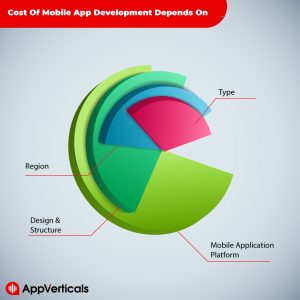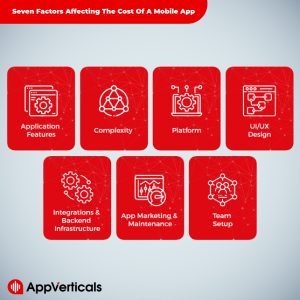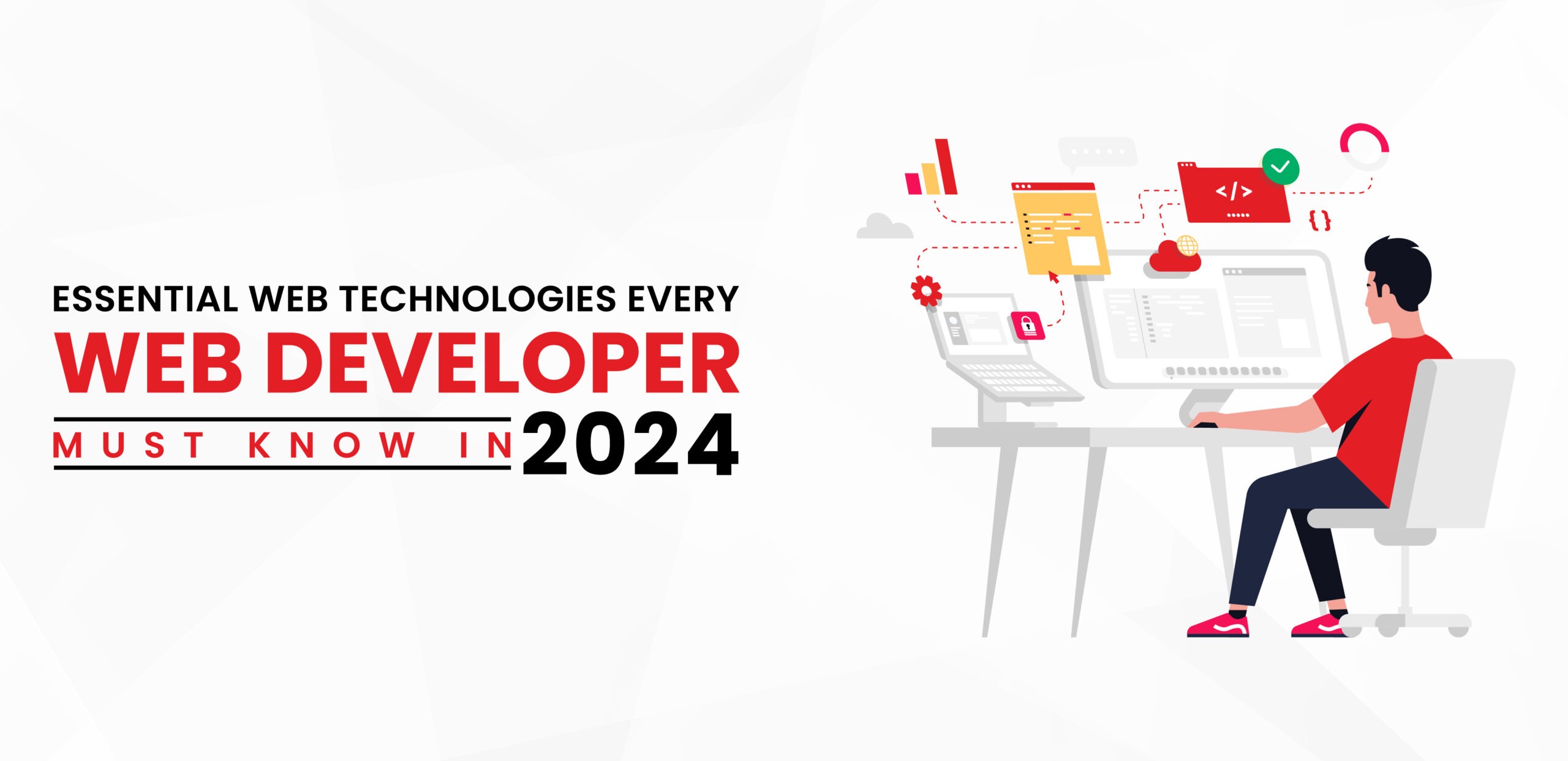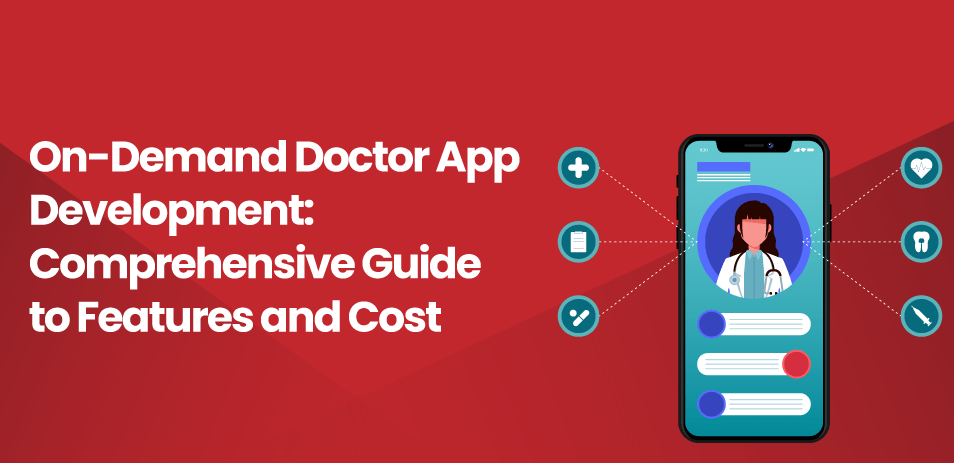Mobile apps are widely used in the modern world, with over 6.6 billion active smartphone users. There is no need to pass them up, given how well-liked they are and how much they generate. You may have asked how much it costs to build an app at one point or another. If you utilize one of the online calculators for app development costs, you will be prompted with some questions before receiving an estimate that could range from $10,000 to $300,000. This broad range is, at best, ambiguous and detrimental for many businesses.
After reading this blog, you will understand how much it costs to create an app, the elements that affect the Cost, and much more, so don’t worry. How much does it, therefore, cost to develop an app? There are several factors to consider when evaluating different price levels for app development. Several other app cost calculators estimate the Cost of an app with various features to cost between $200,000 and $350,000. Smaller apps with few features can cost between $10,000 and $50,000. The Cost to make an app is greatly influenced by various factors, including professional mobile app development services fees, the project’s complexity, and the amount of time required.
| Complexity Level | Description | Features | Development Time | Estimated Cost |
| Simple | Basic app with minimal features. | Basic UI, limited functionality. | 2-4 months | $5,000 – $20,000 |
| Moderate | More features and user interactions. | Enhanced UI, user authentication, database integration. | 4-6 months | $20,000 – $50,000 |
| Complex | Advanced features and integrations. | Custom UI, third-party API integrations, complex backend logic. | 6-10 months | $50,000 – $150,000 |
| Very Complex | Highly intricate app with cutting-edge features. | AI/ML integration, real-time updates, extensive backend development. | 10+ months | $150,000 – $500,000+ |
How Much Does It Cost To Make An App?
Note that these approximate cost estimates can vary significantly based on factors such as development rates, geographic location, platform (iOS app development, Android app development, web app development), design complexity, and additional services like testing, maintenance, and ongoing updates.
Statistics Related to Mobile App Development Cost
- The average Cost of developing a mobile app is $171,450.
- The Cost of developing a simple app can range from $5,000 to $50,000.
- The Cost of developing a complex app can range from $100,000 to $300,000.
- The Cost of developing a native app is higher than the Cost of developing a hybrid or cross-platform app. (GoodFirms)
- The Cost of developing an app in the United States is higher than the Cost of developing an app in other countries. (Statista)
- The Cost of developing an app can vary depending on factors such as the complexity of the app, the features it includes, the platform it is developed for, and the location of the development team.

Mobile App Development Cost by App Type
| App Type | Estimate Cost | Time |
| Mobile App | $30,000 – $300,000 | 1,200 hours |
| iPhone App | $55,000 – $300,000 | 1,200 hours |
| Android App | $50,000 – $300,000 | 1,200 hours |
| Web App | $60,000 – $300,000 | 1,200 hours |
Cost of App Development by Region
Certainly, these average cost ranges for app development in different regions reflect the variations in labor costs, market demand, and economic factors in each region. Let’s break down the explanations for each region:
1- North America:
Average Cost: $100,000 – $200,000
North America has a highly developed tech industry with skilled developers and a strong market demand for apps. This leads to higher development costs due to the higher salaries and operational expenses associated with the region.
2- Europe:
Average Cost: $80,000 – $150,000
Europe also has a well-established tech industry and a pool of experienced developers. While the costs are somewhat lower than North America, they still reflect the high quality of work and expertise available in the region.
3- Asia:
Average Cost: $50,000 – $100,000
Asian countries like India, China, and Southeast Asian nations often offer more affordable development rates due to lower labor costs. The region has large talent pool makes it a popular outsourcing destination for app development.
4- Latin America:
Average Cost: $30,000 – $70,000
Latin American countries like Mexico, Brazil, and Argentina have a growing tech industry and a decent pool of developers. The costs are relatively lower compared to North America and Europe, making it an attractive option for businesses seeking quality development at a lower price point.
5- Africa:
Average Cost: $20,000 – $50,000
Africa is emerging as a tech hub, with countries like Nigeria, Kenya, and South Africa producing skilled developers. Development costs in Africa are generally lower due to lower living costs and emerging tech ecosystems.
It’s important to note that these cost ranges are averages and can vary widely within each region. Additionally, factors like app complexity, features, design, and the specific country within a region can all influence the final app development cost. When considering app development, businesses often need to balance Cost with the level of expertise required to ensure a successful and high-quality product. Always consult with a professional app development company in Dallas to get accurate cost estimates for your specific app project.
| Region | Average Cost |
| North America | $100,000 – $200,000 |
| Europe | $80,000 – $150,000 |
| Asia | $50,000 – $100,000 |
| Latin America | $30,000 – $70,000 |
| Africa | $20,000 – $50,000 |
Seven Factors Affecting Mobile App Development Cost
1- App Features
The price also depends on the app’s functionality. The more time and effort will be put into development, the more intriguing yet challenging the product features are. Typically, we divide apps into three categories based on their complexity: MVPs, medium-complexity apps, and complex apps. A medium app requires more time to develop (about 6-7 months), and a complicated application may take longer—up to nine months—than an MVP with a simple set of capabilities.
Each application has its own unique set of features. The value of your app will depend on what it can do, how users will interact with it, and what users will get out of it. There are several types of mobile software based on the function they perform and various categories based on their complexity.
If your app is simple and consists of a simple list-based information system, your app would cost relatively less than those with large databases and functionalities. Alternatively, dynamic apps require connecting with various platforms and programs through APIs and retrieving user data. On the other hand, game development requires more time and money to develop. It wouldn’t be wrong to say that gaming application development is the most expensive type of application development process.
No matter which app type is selected, there exists a simple, moderate, and complex version of your app, regardless of its complexity. These categories differ mainly in the amount of time spent on development by teams. A simple app can be developed within 300 hours with a basic feature set. The development time of a moderately complex application can range from 500 to 800 hours, including chats, in-app functionalities, and support for APIs. Lastly, complicated applications often require more than 800 hours to develop due to their varied functionality, which often provides custom animation services and graphics.
Learn More About MVP: What is an MVP and Why Is It Important?
2- Complexity
Complexity is a factor that can push up the price of a mobile app from a few hundred dollars to several thousand. For instance, creating a straightforward to-do app would need less work than creating a customized m-commerce application with product photos. Remember that the more complex your software design is, the more it will cost to produce.
3- Platform
Depending on the company’s strategy, a platform for creating mobile apps would be selected. If the service requires an app, it must be made available on popular operating systems like Android and iOS. According to a futuristic viewpoint, most businesses create native and hybrid apps, especially for Android and IOS, to scale their business possibilities. Another type is web applications, full-featured versions of websites optimized for mobile devices.
Notably, hybrid apps are far less expensive than native apps. Additionally, it enables both native and web app functionality. It allows the program to function cross-platform across multiple devices with a single piece of web code. Yet native apps are the most excellent option if User Experience (UX) and top performance are the top priorities.
It increases budget proportion because native Android apps demand more time to code, layout, and fragmentation. Additionally, iOS has the benefit of having a limited number of screen sizes and variants, which allows app development companies to create their products with a reasonable turnaround time.
4- UI/UX Design
Your mobile app’s design is what potential customers see first, so it needs to be eye-catching and enticing. It’s important to position logos, icons, wireframes, user interfaces properly, and many other elements while building mobile apps. The designer’s experience, location, complexity of the design and platform for which the design is to be developed are factors based on which designing costs increase or decrease.
5- Integrations & Backend Infrastructure
Integrations and backend infrastructure significantly influence the Cost of an app. Databases, internal architecture, and other server-related components are all included in the backend. The backend will be more challenging the more complicated your program. You should consider all the integrations your app would require, including connections to things like wearables, messenger, GPS, and payment systems. The secret is simplicity. Don’t add an integration if it is not required.
6- App Marketing & Maintenance
Your work as a developer is not done after you release an app. Your audience needs to be introduced to the app, and marketing is the best way to achieve this. The type of app you have and the target market it is intended for will affect how you market. You have a wide audience if your app is a mobile game, so you must spend more on promotion. For your marketing initiatives, the ideal mobile app developer should always be able to provide or recommend a digital marketing agency.
A developer’s top concern is always making sure your app runs properly. As soon as your app is launched, maintenance begins. Your app needs to change along with the mobile app development business as it continues to develop. You cannot create an app with the hope that it will last forever without any maintenance work from you.
7- Team Setup
The importance of collaborating with the right people who share decent professional values and have the necessary technical skills cannot be stressed enough. Hiring responsible software engineers should be your top priority if you want to create a high-quality product. Outsourcing is your only option if you cannot hire in-house developers permanently. The most popular way to outsource app development is to hire a mobile app development company or hire a freelancer who can take care of your project throughout the entire process, from planning to post-production. Clients must choose an engagement model that defines a contracting basis for collaboration that describes the working process.

Hidden App Development Costs That Require Your Attention
App development costs can extend beyond the initial budget due to various hidden or unexpected expenses. Awareness of these potential costs is essential to ensure your project stays within your financial expectations. Here are some hidden app development costs you should know:
1- Design Revisions
The design of an app is a crucial component, and changes could be required to get the desired appearance and user experience. Increased expenditures can result from more design revisions, especially if you’re working with a design agency or using freelancers.
2- Feature Creep
You might consider fresh concepts or features to include in your app as the development process progresses. Innovation is good, but these improvements could lengthen the time and expense of development. It’s crucial to think carefully about whether each new feature is necessary or if it can wait for a later upgrade.
3- Platform and Device Testing
Your app must operate seamlessly across a range of platforms and devices. Testing across various operating systems, devices, and screen sizes may uncover unanticipated issues or inconsistencies that require further development and testing efforts.
4- Third-Party Services and Integrations
There may be expenses if your app uses third-party services, APIs, or integrations. Some services include free tiers, but you might need to upgrade to paying plans as your user base expands to handle the additional consumption.
5- Security and Compliance
It could be necessary to do more development work to guarantee user data security and abide by industry rules. Putting strong security measures into place and dealing with compliance difficulties can be difficult and time-consuming.
6- App Store Fees
There are costs involved with listing and maintaining your app after you’re ready to publish it on app marketplaces like Apple’s App Store or Google Play. These costs may include yearly renewal fees and one-time developer account payments.
7- App Updates and Maintenance
Your software will require continuing upgrades and maintenance after the initial launch to solve issues, add new features, and maintain compatibility with the newest hardware and operating system releases. Continuous development costs may result from this.
8- Marketing and Promotion
To achieve traction and customers, even the finest apps require efficient marketing. Advertising, public relations, and social media campaigns are all examples of marketing expenses that may pile up.
Mobile App Development Team Models
Regarding mobile app development, several options exist for forming a hiring team. Each option has its advantages and disadvantages, and the choice depends on factors like budget, project complexity, timeline, and desired level of control. Here are the options you mentioned:
Hire a Local Agency:
Hiring a local app development agency can be beneficial if you want to work with a team that has a proven track record and expertise in building mobile apps. Agencies usually have a team of professionals with diverse skills, including designers, developers, testers, and project managers. This option provides a structured approach to development and can often deliver high-quality results.
Pros:
- Expertise: Agencies have experienced professionals.
- Diverse Skills: Agencies have specialists for various tasks.
- Project Management: They usually handle project management.
Cons:
- Cost: Agencies can be more expensive than other options.
- Communication: There might be communication challenges if the agency is not local.
- Control: You might have less control over the development process.
Crafting Your Ideal Mobile App/Experience Starts Here!
Ready to elevate your business? Your custom app is just a click away.
Yes Let’s goBuild an In-House Team:
Building an in-house app development team involves hiring full-time employees who will work exclusively on your projects. This can provide you with more control and direct communication with the team.
Pros:
- Control: You have direct control over the team and the project.
- Collaboration: Team members work closely and are dedicated to your projects.
- Long-Term Commitment: In-house teams can lead to better alignment with your business goals.
Cons:
- Recruitment: Hiring and retaining skilled professionals can be challenging.
- Costs: In-house teams come with salary, benefits, and infrastructure costs.
- Expertise: Maintaining diverse expertise might be difficult.
Work with Freelancers:
Hiring freelancers can be a cost-effective way to access specialized talent for specific tasks. Freelancers are often skilled professionals who can work on a project basis.
Pros:
- Flexibility: You can hire freelancers for specific tasks or roles.
- Cost-Effective: Freelancers can be more budget-friendly than agencies or in-house teams.
- Quick Scaling: You can easily scale up or down as needed.
Cons:
- Quality Varies: Freelancer quality and reliability can vary.
- Coordination: Managing multiple freelancers can be challenging.
- Communication: Clear communication can be crucial when working remotely.
Outsource App Development:
Outsourcing involves partnering with a development company located in a different region or country. This option can offer cost savings and access to skilled professionals.
Pros:
- Cost Savings: Outsourcing can be more affordable than hiring locally.
- Expertise: You can tap into specialized skills from around the world.
- Focus on Core Business: This allows you to focus on your business’s core activities.
Cons:
- Time Zone Differences: Time zone variations might affect communication.
- Quality Assurance: Ensuring quality can be challenging with remote teams.
- Cultural Differences: Cultural nuances might impact collaboration.
Ultimately, the right approach depends on your project’s specifics, budget, timeline, and your own preferences. Many organizations even adopt a hybrid model, combining in-house resources with outsourced talent to get the best of both worlds.
| Option | Cost |
| Hire a local agency | $50,000 – $200,000+ |
| Build an in-house team | $100,000 – $500,000+ |
| Work with freelancers | $20,000 – $100,000+ |
| Outsource app development | $15,000 – $150,000+ |
App Development Cost Calculators
Several widely recognized application development cost calculators are available to assist in obtaining a preliminary assessment of your application’s financial requirements. Here is a compilation of some such tools:
AppVerticals App Cost Calculator: This complimentary tool employs a series of inquiries to approximate application development expenses. Upon completion of these queries, a comprehensive breakdown of development costs, including the requisite labor hours, is promptly provided, culminating in the total expense for application development.
Inoxoft: This tool gauges the projected expense of application development based on your selections about the platform, design, security features, and functionalities. The resultant development cost for your application is instantaneously retrieved and presented.
Litslink: Through a meticulous examination involving 27 comprehensive questions encompassing aspects such as product design, essential features, communication, interactivity, security and ownership provisions, and promotional strategies, Litslink ascertains the expense associated with application development. However, it withholds this cost information until your data is entered.
Buildfire: A comprehensive calculator that affords many options and filters for approximating application development costs. Parameters comprise platform specifications, anticipated user base, requisite features, maintenance and hosting considerations, potential monetization strategies, integration requirements, and supplementary Buildfire services.
Additionally, cloud-centric cost calculators offered by prominent providers such as AWS, Azure, and GCP can provide a preliminary assessment of the expenditure involved in hosting the application’s infrastructure and data within a cloud environment.
Crafting Your Ideal Mobile App/Experience Starts Here!
Ready to elevate your business? Your custom app is just a click away.
Yes Let’s goConclusion
The Cost of designing a mobile app depends on several factors. These include the mobile platform, the type of app, its quality, geographic location, complexity, features, and custom elements. Numerous other aspects also influence the Cost of developing a mobile app. These range from validating the concept to creating an exceptional UI/UX design. Additionally, choosing a target audience and defining an appropriate design theme are crucial steps in the process. Insisting on developing an app that merely matches your competitors is not a strategic approach. Instead, opting for superior app designs that distinguish you from your competitors will ensure a higher return on your investment. We provide the best app development services; you can contact us for assistance. Feel free to contact us to learn how we can help you in this journey.








